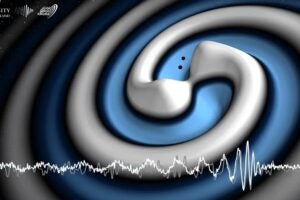AUSTIN, Texas Scientists investigating cracks along the outer continental shelf off the mid-Atlantic seacoast say the entire area is charged with natural gas and the cracks actually may have been caused by natural gas erupting through the seafloor.
Dr. John Goff, a research scientist at UT Austin’s Institute for Geophysics, lead researcher Dr. Neal Driscoll of the Woods Hole Oceanographic Institution and Dr. Jeffrey Weissel of Columbia University’s Lamont-Doherty Earth Observatory earlier reported that underwater landslides in this area could have the potential to trigger tsunamis.
Such tsunamis, sometimes inaccurately referred to as tidal waves, could have a devastating effect on high population areas along the mid-Atlantic coast. Their research was published in the May 2000 issue of the journal Geology.
Following up on this report, the scientific team conducted a two-week study aboard the Research Vessel Cape Hatteras operated by Duke University. This cruise, from May 7 through May 20, was funded under a grant from the Marine Geology and Geophysics program of the National Science Foundation (NSF). Preliminary results indicate the cracks are a system of large depressions along the continental shelf edge that appear to have been excavated by natural gas.
“We don’t know the source of the gas,” said Driscoll. “But it is clear that gas has played an important role in the formation of these features. The gas is trapped under layers of sediment on the shelf edge until some circumstance causes it to escape blowing holes in the seafloor to form these large pockmark features we thought were cracks.”
Although the team had speculated that rising gas might play a part in triggering shelf-edge
collapse, they were surprised at the quantity of gas and the apparent vigor of the “blowout” process.
UT Austin’s Goff said: “Gas is pervasive in and around the blowouts. It shows up clearly on our seismic data as a very bright, diffuse reflection wiping out any deeper signals.
“What we can say with some confidence is that these blowout features occur where they do because layers of relatively impermeable sediment draped over the edge of the shelf form a trap that catches and accumulates the gas,” Goff said. “This allows pressure to build until the gas breaks through the seafloor, presumably throwing sediment up into the water column where it is carried away by the bottom currents.”
“A great deal more work is needed before any definitive statements can be made,” Weissel said. But he added: “Regardless of the source, it is apparent that gas charging plays a critical role in the
area, and that the ongoing process of blowouts could conceivably weaken the shelf edge and contribute to a submarine landslide/tsunami scenario.”
Driscoll said the impermeable layers appear to be remnants of an ancient delta that reached far out from the current coastline during the last ice age, when sea levels were much lower than today. “We recovered samples of silty clay, sand and gravel from the bottom that are consistent with a deltaic source. Where these deposits are absent, the gas appears to percolate harmlessly to the surface,” Driscoll said.
The scientists say the blowouts some as large as 2000 meters (6,500 feet) across, 50 meters (165 feet deep) and up to 5,000 meters (16,400 feet) long occur in a line along the shelf edge. That suggests there is some geological mechanism at work underneath the features, or their trend and shapes might be due to their proximity to the shelf edge.
The scientists said there is evidence that the area has been subject to previous collapses.
An enormous slide occurred just to the south some 18,000 years ago at the end of the last ice age.
“Gas is also present in the slide area,” Goff said. “But whether that long-ago collapse resulted from a similar process of gas charging and shelf-edge blowouts and, if so, when the next one might
occur, remains to be determined.”
Further research will be necessary to determine the real risk to adjacent coastal communities of a submarine landslide and associated tsunami.
The primary tool used during the recent cruise was SUBSCAN, a state-of-the-art seafloor and sub-bottom imaging system, designed by EdgeTech of Boca Raton, Fla., in collaboration with researchers at Florida Atlantic University and Woods Hole Oceanographic Institution. The device, towed behind the ship over the seafloor, was in the water 24 hours a day for 11 straight days, enabling the team to return home with more than 2,000 kilometers (1,250 miles) of geophysical data.
For more information, contact Dr. John A. Goff or Katherine Ellins at the UT Austin Institute for Geophysics (512) 471-6156 or (512) 232-3251 or e-mail goff@utig.ig.utexas.edu, Shelley Lauzon, media relations Woods Hole Oceanographic Institution (508) 289-2270 or email slauzon@whoi.edu or Kurt Sternlof at the Columbia Earth Institute (914) 365-8747.



